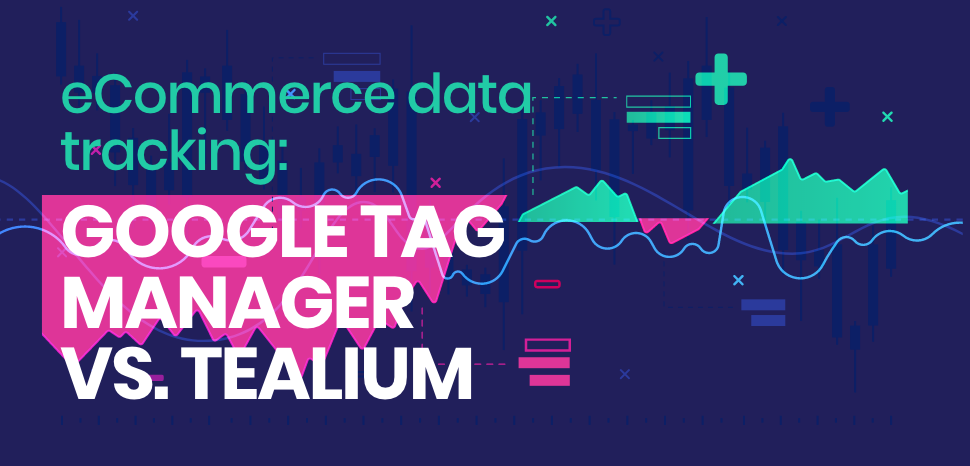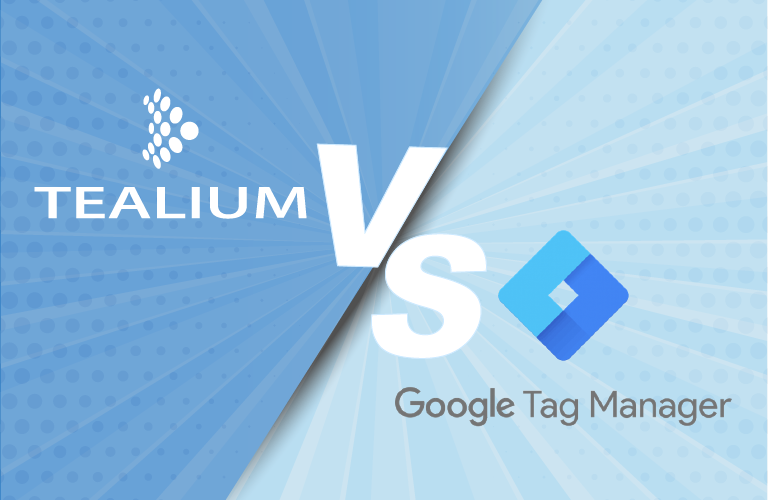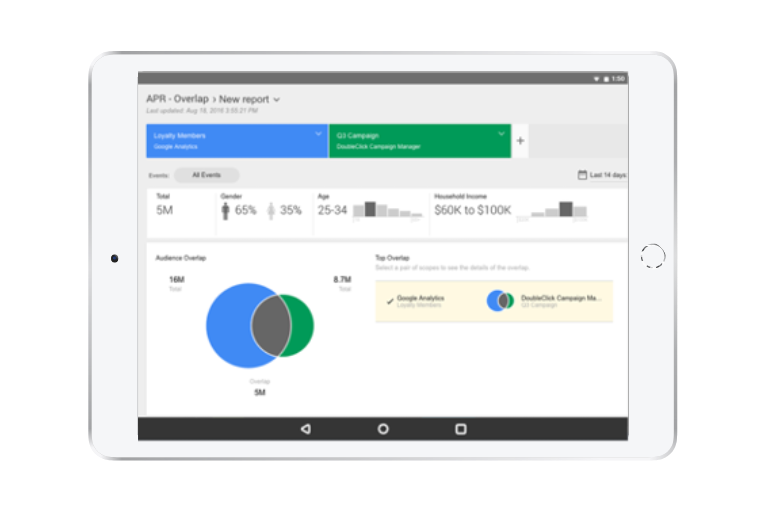eCommerce data tracking: Google Tag Manager vs. Tealium

Article topics
- What are tracking tags?
- What is a tag management system?
- Google Tag Management vs. Tealium
- GTM and Tealium features comparison
- Final thought
Google Tag Manager and Tealium make SMB eCommerce data gathering easier and more efficient. But which one is better?
Running a successful eCommerce business requires you to gather data about how your webstore and marketing efforts are performing. This applies equally regardless of business size. Both SMB and enterprise eCommerce businesses gather the same types of consumer data to help inform business decisions.
Understanding how consumers interact with your webstore enables you to better gauge what’s working and what’s not. The deeper insights that tracking tags can give help you target spend where it’s needed, for marketing and on improving user experience (UX).
What are tracking tags?
A tracking tag is a small piece of code assigned to send data about page elements to your webstore analytics, so you can track consumer actions as they browse. This gives you deeper insights into webstore performance and enables KPI tracking to maximise ROI.
Tracking tags help eCommerce businesses understand how different webstore elements and consumer actions are performing by gathering data about them: page hits, button clicks, form submissions, scrolling, file downloads, cart activity or any number of other elements and actions. Tracking tags can also be used to generate heatmaps, for remarketing, and to help better understand customer acquisition, for example where traffic to your webstore is coming from—emails, social media etc. The easiest way to use tracking tags is with a tag tracking system.
What is a tag management system?
Tracking tag management systems (TMS) are user-friendly, web-based interfaces that simplify the process of creating and deploying tags, enabling you to add, edit and disable tags without getting bogged down in source code (JavaScript).
Before the advent of TMS each tag would have to be hard coded within a webstore’s pages. Google Analytics and other tracking tag providers required individual coding to trigger individual actions. The code would be created by a developer and added to the next code update for deployment. Only then would new tags go live. This of course resulted in delays in tag implementation. And if there were tag coding errors, the process would need to begin again, causing further delays and frustration for marketers who rely on the data that tracking tags provide.
A TMS streamlines tracking tag creation and the deployment process, enabling tags to be setup and published more quickly and easily, independent of code updates, and be assigned custom variables and triggers via the user-friendly TMS interface.
There are three elements to creating and deploying tracking tags: the tags themselves, triggers and variables:
- As we have already seen, tags are snippets of JavaScript or tracking pixels
- Triggers are a way to fire the tags. They tell the TMS what action will activate the tag, such as button click, form submission etc.
- Variables are additional information that TMS may need for a tag and trigger to work, such as an event, target, text or URL.
It’s important to note that although a TMS makes it much easier to create and manage tracking tags, some prior knowledge of how tags, triggers and variables work is necessary to be able to create and deploy tracking tags effectively using a TMS.
Google Tag Management vs. Tealium

Launching in 2012, Google Tag Manager (GTM) is a popular TMS. GTM is used by many brands and businesses across a variety of sectors around the world. Even though GTM is a Google product, it is not restricted for use with other Google products, such as AdWords or Analytics. GTM can be used to manage social media tracking tags, such as Facebook pixels, and other third-party tags.
Tealium is a TMS in much the same way as GTM. It enables marketers to create, deploy and update tracking tags without having to crunch code. There are however a few important differences. Tealium features advanced tag deployment with over tag templates. It also offers technical support for specific issues.
GTM and Tealium have similar functionality and ultimately do a very similar job—setting up, deploying and updating tracking tags. The two systems have some subtle differences in what features and capabilities that they offer.
Cost
Tealium offers a 30-day free trial with price plans beginning at around £120 per month. GTM is free. All you need to do is create a Google account and you can begin using GTM.
Templates
Tealium offers over 1000 custom templates. A tag template is a piece of JavaScript that either builds a tracking pixel or sets specific variables. Tealium’s templates also serve to add functionality not provided by the tag. For example, they can grab a cookie value and send it to your webstore analytics tools for richer tracking data.
GTM has tag template capability, but its templates must be created by you or your developer. Once they are created then they can be used in the same way as Tealium’s templates. This is a double-edged sword, as with Tealium you have plenty of templates to choose from straight away, and although you have to create templates for GTM, you can create them for your specific needs.
Also, GTM template community can offer a wide choice of shared templates, and Tealium has its Tag Marketplace for additional templates.
Social media
Using tracking tags for your social media content enables you to better understand which platform is driving most consumers to your webstore and what content is engaging them. You can also determine which links gain the most webstore page views after the initial click and what social media content leads to the most conversions. And tracking targeted topics can help to optimise your social media listening strategy.
Both Tealium and GTM enable you to tag your social media content to track consumer engagement.
Multiple triggers
GTM has multiple trigger capability, where several triggers can be added to a tag, firing it if any one of those triggers is activated. On the other hand, with Tealium, if multiple triggers are applied to a tag, all of those triggers must be met before the tag is fired. This means that sometimes it’s necessary to create separate trigger rules for specific tags in Tealium.
Extensions
Instead of the custom variable methods found in GTM, Tealium uses extensions. You can do all the same things you can do with a custom variable plus more. For example, some extensions help you manage other things such as privacy settings. There is also an extension that helps you manage your eCommerce variables so they can be automatically mapped correctly.
Workspaces
Tealium’s workspace is setup in such a way that it’s possible for multiple users to encroach on each other’s work. With GTM team members can work on creating or updating tags in separate workspaces. Changes made can be reverted to previous configurations and nobody can accidentally publish someone else’s incomplete changes.
With GTM several team members work can be merged on completion to allow it to be published all at the same time. GTM 360 offers unlimited workspaces.
Auto save
Tealium has an auto sign out feature, which while good for security, can be problematic because it doesn’t auto-save, requiring work to be saved manually. This can result in work being lost. GTM auto-saves in Preview, so it’s unlikely that work will be lost due to it not being manually saved.
Support
A significant advantage that Tealium has over GTM is that it offers technical support with customer service representatives. This gives new users and users stepping into advanced features valuable guidance. GTM does offer support, but it is only available online.
GTM and Tealium features comparison
| Tealium | |
|---|---|
| Features | |
| Campaign Management | NO |
| Conversion Tracking | YES |
| Goal Tracking | NO |
| Keyword Tracking | YES |
| Multiple site management | NO |
| Pageview Tracking | YES |
| Referral Source Tracking | YES |
| Site Search Tracking | YES |
| Time on Site Tracking | YES |
| User Interaction Tracking | YES |
| Google Tag Management | |
|---|---|
| Features | |
| Campaign Management | NO |
| Conversion Tracking | YES |
| Goal Tracking | YES |
| Keyword Tracking | YES |
| Multiple site management | YES |
| Pageview Tracking | YES |
| Referral Source Tracking | YES |
| Site Search Tracking | YES |
| Time on Site Tracking | YES |
| User Interaction Tracking | YES |
| Platform | |
|---|---|
| Cloud | YES |
| Windows | NO |
| Mobile | YES |
| iOS | NO |
| Android | YES |
| Platform | |
|---|---|
| Cloud | YES |
| Windows | NO |
| Mobile | YES |
| iOS | NO |
| Android | NO |
| Support | |
|---|---|
| 24/7 Live Rep | NO |
| Business Hours Live Rep | NO |
| Online | YES |
| Support | |
|---|---|
| 24/7 Live Rep | NO |
| Business Hours Live Rep | YES |
| Online | YES |
| Training | |
|---|---|
| In Person | NO |
| Live Online | NO |
| Webinars | NO |
| Documentation | YES |
| Training | |
|---|---|
| In Person | YES |
| Live Online | YES |
| Webinars | YES |
| Documentation | YES |

GTM and Tealium have very similar features. Tealium offers a large template library and has more comprehensive support and training options than GTM. However, GTM being a Google application will be valuable for some businesses, given Google’s reputation for innovation and the fact that many businesses will already be using Google Analytics. And GTM has many more users than Tealium, so its user community is much bigger.

Final thought
Tealium and GTM are both valuable TMS for tagging and tracking consumer data on your webstore and beyond, more accurately gauging marketing campaign performance and helping to improve UX. But while using TMS can offer you valuable insights into what is and what isn’t working in your eCommerce business, it’s crucial to fully understand how tracking tags work. Because tracking tags are created using source code, they can have a marked impact on page structure and page load speeds, so it’s vital that they are created and deployed correctly.
Skilfully creating and deploying tracking tags using a TMS can reveal valuable insights into business performance, harnessing the KPI and campaign data that you find most valuable. This will help reduce friction in consumer journeys and enable your marketing campaigns work smarter, for reduced marketing spend and increased conversion rates.
Is your eCommerce business harnessing the masses of data held within your webstore or on your social media platforms? If you would like to learn know more about using tracking tags then get in touch today for a chat with one of our eCommerce marketing experts.


 Back
Back
